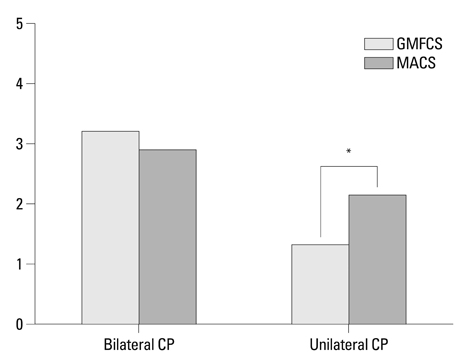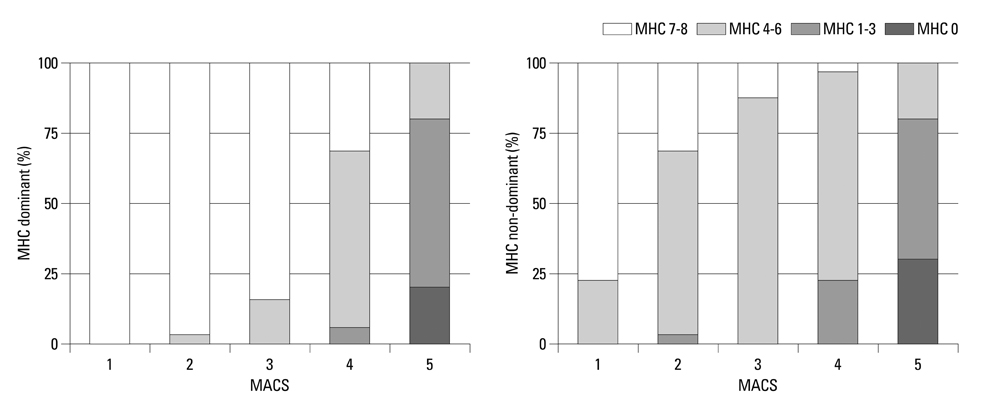Yonsei Med J.
2013 Mar;54(2):516-522. 10.3349/ymj.2013.54.2.516.
Relation among the Gross Motor Function, Manual Performance and Upper Limb Functional Measures in Children with Spastic Cerebral Palsy
- Affiliations
-
- 1Department and Research Institute of Rehabilitation Medicine, Yonsei University College of Medicine, Seoul, Korea. eungeol@gmail.com
- KMID: 1503919
- DOI: http://doi.org/10.3349/ymj.2013.54.2.516
Abstract
- PURPOSE
The objective of this study was to describe hand function in relation with gross motor function and subtype of spastic cerebral palsy and to investigate the relationships among gross motor function, bimanual performance, unimanual capacity and upper limb functional measures in children with spastic cerebral palsy (CP).
MATERIALS AND METHODS
We collected upper extremity data of 140 children with spastic CP. The Gross Motor Functional Classification System (GMFCS) was used to assess gross motor function, Manual Ability Classification System (MACS) for bimanual performance, and Modified House Functional Classification (MHC) for the best capacity of each hand. Upper limb functions were evaluated by using the Upper Limb Physician's Rating Scale and Upper Extremity Rating Scale.
RESULTS
There was a good correlation between GMFCS and MACS in children with bilateral CP, but the correlation was not strong in children with unilateral CP. No significant difference between GMFCS and MACS was found in children with bilateral CP, but children with unilateral CP scored higher on GMFCS than on MACS. A strong correlation was observed between MACS and MHC in children with bilateral CP, but not in children with unilateral CP. The upper limb functional measures in each hand were highly related with MACS and MHC in bilateral CP, but not in unilateral CP.
CONCLUSION
Gross motor function, bimanual performance and the best capacity of each hand are closely related with each other in children with bilateral CP, but not in children with unilateral CP.
Keyword
MeSH Terms
Figure
Reference
-
1. Eliasson AC, Krumlinde-Sundholm L, Rösblad B, Beckung E, Arner M, Ohrvall AM, et al. The Manual Ability Classification System (MACS) for children with cerebral palsy: scale development and evidence of validity and reliability. Dev Med Child Neurol. 2006. 48:549–554.2. Rosenbaum PL, Palisano RJ, Bartlett DJ, Galuppi BE, Russell DJ. Development of the Gross Motor Function Classification System for cerebral palsy. Dev Med Child Neurol. 2008. 50:249–253.
Article3. McConnell K, Johnston L, Kerr C. Upper limb function and deformity in cerebral palsy: a review of classification systems. Dev Med Child Neurol. 2011. 53:799–805.
Article4. Morris C, Kurinczuk JJ, Fitzpatrick R, Rosenbaum PL. Reliability of the manual ability classification system for children with cerebral palsy. Dev Med Child Neurol. 2006. 48:950–953.
Article5. Carnahan KD, Arner M, Hägglund G. Association between gross motor function (GMFCS) and manual ability (MACS) in children with cerebral palsy. A population-based study of 359 children. BMC Musculoskelet Disord. 2007. 8:50.
Article6. Gunel MK, Mutlu A, Tarsuslu T, Livanelioglu A. Relationship among the Manual Ability Classification System (MACS), the Gross Motor Function Classification System (GMFCS), and the functional status (WeeFIM) in children with spastic cerebral palsy. Eur J Pediatr. 2009. 168:477–485.
Article7. van Meeteren J, Nieuwenhuijsen C, de Grund A, Stam HJ, Roebroeck ME. Transition Research Group South West Netherlands. Using the manual ability classification system in young adults with cerebral palsy and normal intelligence. Disabil Rehabil. 2010. 32:1885–1893.
Article8. House JH, Gwathmey FW, Fidler MO. A dynamic approach to the thumb-in palm deformity in cerebral palsy. J Bone Joint Surg Am. 1981. 63:216–225.
Article9. Van Heest AE. Surgical management of wrist and finger deformity. Hand Clin. 2003. 19:657–665.
Article10. Koman LA, Williams RM, Evans PJ, Richardson R, Naughton MJ, Passmore L, et al. Quantification of upper extremity function and range of motion in children with cerebral palsy. Dev Med Child Neurol. 2008. 50:910–917.
Article11. Waters PM, Zurakowski D, Patterson P, Bae DS, Nimec D. Interobserver and intraobserver reliability of therapist-assisted videotaped evaluations of upper-limb hemiplegia. J Hand Surg Am. 2004. 29:328–334.
Article12. Arner M, Eliasson AC, Nicklasson S, Sommerstein K, Hägglund G. Hand function in cerebral palsy. Report of 367 children in a population-based longitudinal health care program. J Hand Surg Am. 2008. 33:1337–1347.
Article13. Klingels K, Jaspers E, Van de Winckel A, De Cock P, Molenaers G, Feys H. A systematic review of arm activity measures for children with hemiplegic cerebral palsy. Clin Rehabil. 2010. 24:887–900.
Article14. Graham HK, Aoki KR, Autti-Rämö I, Boyd RN, Delgado MR, Gaebler-Spira DJ, et al. Recommendations for the use of botulinum toxin type A in the management of cerebral palsy. Gait Posture. 2000. 11:67–79.
Article15. McDowell B. The Gross Motor Function Classification System--expanded and revised. Dev Med Child Neurol. 2008. 50:725.16. Sakzewski L, Ziviani J, Boyd R. The relationship between unimanual capacity and bimanual performance in children with congenital hemiplegia. Dev Med Child Neurol. 2010. 52:811–816.
Article17. Öhrvall AM, Eliasson AC, Löwing K, Ödman P, Krumlinde-Sundholm L. Self-care and mobility skills in children with cerebral palsy, related to their manual ability and gross motor function classifications. Dev Med Child Neurol. 2010. 52:1048–1055.
Article18. Rosenbaum P, Paneth N, Leviton A, Goldstein M, Bax M, Damiano D, et al. A report: the definition and classification of cerebral palsy April 2006. Dev Med Child Neurol Suppl. 2007. 109:8–14.19. Prevalence and characteristics of children with cerebral palsy in Europe. Dev Med Child Neurol. 2002. 44:633–640.
- Full Text Links
- Actions
-
Cited
- CITED
-
- Close
- Share
- Similar articles
-
- Botulinum Toxin Treatment on Upper Limb Function in School Age Children With Bilateral Spastic Cerebral Palsy: One Year Follow-up
- Effects of Hippotherapy on Gross Motor Function and Functional Performance of Children with Cerebral Palsy
- The Effectiveness of Selective Posterior Rhizotomy for the Rehabilitation in Children with Cerebral Palsy
- Contributing Factors Analysis for the Changes of the Gross Motor Function in Children With Spastic Cerebral Palsy After Physical Therapy
- Relationship Between Gross Motor Function and Daily Functional Skill in Children With Cerebral Palsy



